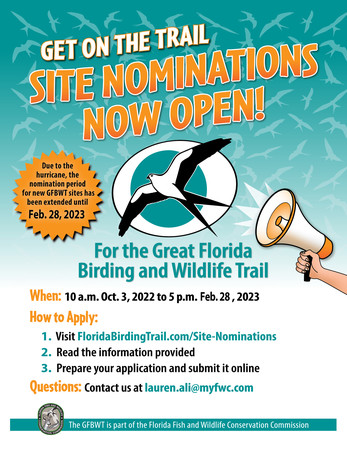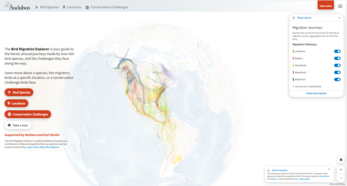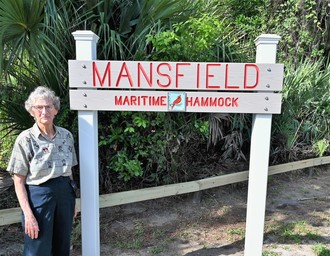|
On Sept. 28, 2022, Hurricane Ian made landfall near Fort Myers, resulting in severe damage to many parts of Florida. As a result, many Great Florida Birding and Wildlife Trail sites in affected areas are partially or totally closed for repair and restoration.
Check the home page of our website for a list of sites experiencing closures and for further updates as sites begin opening for public use. However, be aware that some sites, particularly those in Southwest Florida, may be closed for several months. Thank you for your patience and understanding.
 Flyer announcing the opening of new GFBWT site nominations.
After some delays due to Hurricane Ian, the Great Florida Birding and Wildlife Trail is excited to announce that we will be accepting nominations for new sites from 10 a.m. Oct. 3, 2022, to 5 p.m. Feb. 28, 2023.
A 2020 study of GFBWT users showed that 92% of respondents were satisfied with the Trail, with 73% being very satisfied. To continue this strong public trust in the recommendations of the GFBWT, we are seeking sites that exemplify Florida’s excellent birding and other wildlife viewing opportunities. GFBWT sites range in their “wildness,” and we will consider a range of sites from relatively untouched wilderness to areas with more well-developed infrastructure.
Nominations must be submitted by the person authorized by the agency or organization in charge of the site, but members of the public are welcome and encouraged to share this opportunity with site managers and help them prepare application materials.
Find all the details on our website!
 Screenshot of Bird Migration Explorer.
Few things capture the imagination like birds in flight, especially when that flight spans thousands of miles and multiple continents. Bird Migration Explorer uses animated, interactive maps to show the full annual migrations of 458 bird species that breed in the U.S. and Canada like you’ve never seen them before. Not only do they show the location and timing of migration routes and tagged bird encounters, but they also display conservation challenges different species encounter on their journeys, including light pollution, human developments, drought and more.
This comprehensive, innovative platform is the result of a partnership pooling the data and resources of ten highly respected ornithological and geospatial institutions, including National Audubon Society, Smithsonian Migratory Bird Center, Movebank and Esri. Check out this article from National Audubon Society to learn more.
 Phyllis Mansfield stands next to a sign declaring the site’s new name. Image provided by Florida's Space Coast Office of Tourism.
From a bird’s eye view, the area formerly known as Lori Wilson Park stands out as a green oasis between hotel rooftops. The park, located on Space Coast’s Cocoa Beach, is the last place providing easy public access to a maritime hammock along Florida’s east coast. 222 bird species have been observed at this eBird Hotspot, and the park has recently been renamed in honor of the top observer, Phyllis Mansfield, and her late husband, Howard.
Phyllis and Howard Mansfield started volunteering at Lori Wilson Maritime Hammock in 1990. For more than 25 years, Phyllis visited this hammock almost daily to observe and count birds, lead bird tours, and submit her observations to birding websites. Together, the Mansfields removed litter and exotic plants from the hammock, cleaned and filled bird feeders, maintained a watering pond and reported species to bird watchers. Phyllis is not only an avid birder but an advocate for native plants. With the help of a group called the Cocoa Beach Tree People, Phyllis spent decades removing invasives like Brazilian Pepper in the hammock and throughout Cocoa Beach.
Even after the Mansfields downsized after 54 years in Cocoa Beach and moved just across the Banana River to Merritt Island, Phyllis still finds her way back to walk the beach and look for birds most mornings. Sadly, she observed that fewer migratory birds now frequent the area than in past years when this maritime hammock was one of the best migratory bird destinations in Florida. Phyllis said, “This maritime hammock is a wonderful part of the greater Lori Wilson Park, and I hope my friends - county residents, birders and volunteers - will all work to ensure this maritime hammock’s wildlife habitat will be restored by removing and replacing invasive plants with desirable bird attractors and a water feature.”
Over 2 million people visit The Mansfield Maritime Hammock Park each year, and the Space Coast Office of Tourism is undertaking a major renovation of the area. In addition to protecting the hammock, the crossovers, boardwalks, bathrooms and showers are all being refurbished. This investment will ensure that visitors both human and avian will be able to enjoy the hammock for many more years.
Visit the GFBWT website for more information about the site.
The GFBWT would like to thank the Space Coast Office of Tourism for providing images and quotes for this article.
|